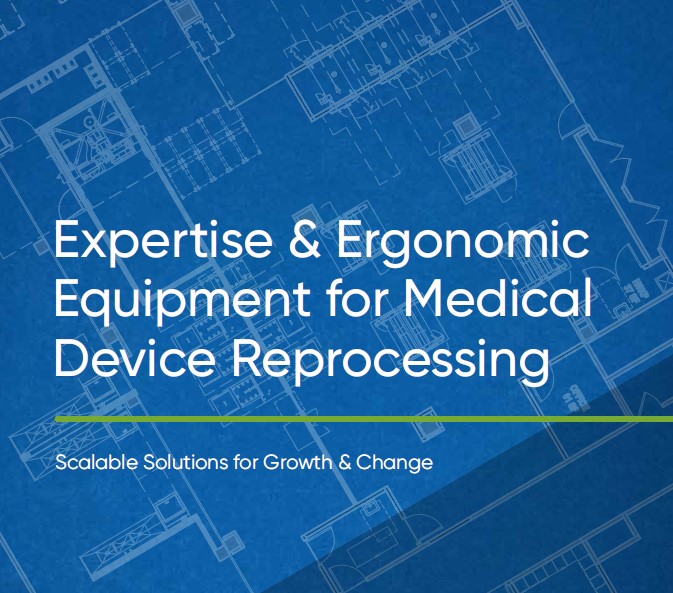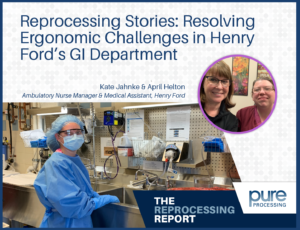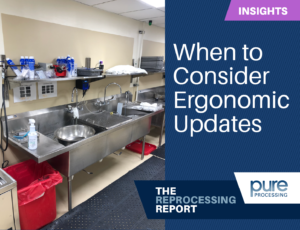From upgrades & enhancements to existing equipment, to new hospital department builds, Pure Processing helps medical facilities achieve three key objectives for their equipment investments:
1. Optimal patient safety outcomes
2. Enhanced operational efficiencies
3. Reduced costs associated with worker injuries & ergonomics, instrument damage, and infection risks
By leveraging our expertise and collaborative, partnership-first approach, we can help facilities protect their most important assets: their staff and instrumentation.
To learn about our full project capabilities, expertise, and approach, download our Project Capabilities brochure below to get started on your equipment journey with Pure Processing.

Interested in learning more? We'd love to partner with you!
Read more regarding projects, industry guidelines, and customer insights.

Reprocessing Stories: Resolving Ergonomic Challenges in Henry Ford’s GI Department
Over the past 37 years, Kate Jahnke has served her patients and staff at the Henry Ford Health System across multiple departments, 20 in GI. Jahnke’s journey into the position was somewhat serendipitous. She transitioned into GI after an initial role in the ER and since 2020, she’s been working at Henry Ford Health System, Columbus, first as a contingent and then full-time. When her long-time supervisor left, she was encouraged to step into the role. Jahnke is also accompanied by longtime team member April Helton, who has worked alongside Jahnke as a medical assistant for 16 years. Henry Ford & Jahnke’s Super Star Team Jahnke’s department operates in a freestanding ambulatory site; a three-story building that is part of the Henry Ford Health System. This system includes their main campus downtown and several ambulatory sites across the area, as well as a larger department in West Bloomfield Hospital. Her site operates five days a week, reprocessing approximately 150 procedures a week or around 30-38 procedures daily. Jahnke is proud to say her team is staffed with the highest quality endoscopy techs. As Jahnke states: “Our loyalties I think are rare… and the camaraderie is rare. Anytime we get a big group of people, especially women, we support each other in many aspects of our [personal] and our work lives.” This mutual support creates an enjoyable and fulfilling workplace. The Henry Ford team takes pride in the quality of their care, and their patients can sense that positive environment. It’s part of the secret that inspires Jahnke and her team. Ergonomic Concerns in Decontamination While Jahnke and Helton had the superstar team, their department struggled with ergonomic challenges. Their fixed-height sinks were leading to back pain and poor working postures for a team of people with varying heights. Helton shares: “Our biggest issue was that we have varying heights among our technicians. So, our sink was kind of low. And that was a problem for a lot of our taller technicians, who had to bend over to work at them.” In addition to including height-adjustability into their new sink’s design, Jahnke’s goal was also to update and improve functionality, workflow, and durability compared with the old sinks. According to Jahnke: “We were looking for something that was updated, down to the fact that our sink had been used since 2012. There was some wear and tear on it, old plumbing, and leaks. They weren’t functioning any longer.” The department needed a solution that addressed these concerns and provided an ergonomic space for the team. Consultation Process with Pure Processing Jahnke first learned of Pure Processing through other ambulatory sites within Henry Ford System, which had recently opened and implemented PureSteel™ Healthcare Reprocessing Sinks. The success of these projects, and the satisfaction of the facilities, led to Pure Processing being brought in to help with this project. While the consultation and design process was standardized and streamlined due to previous collaborations, Pure Processing representatives, were “really helpful and easy to talk to”, to according to Jahnke. Having worked on similar projects at other sites, they brought valuable experience and familiarity to the table. However, they faced unique challenges due to the age and size of the building; the decontamination space was limited compared newer buildings on campus. Installation Hurdles Logistics presented significant challenges regarding installation of the sink. The older building wasn’t equipped with a loading dock, which created unique challenges associated with delivering the sink. Additionally, the layout of the building made navigation to the reprocessing space difficult, requiring partial disassembly of some components. Their representative was onsite for the install and helped remedy challenges as they arose. Despite these challenges, Jahnke explained “Anytime we had one of these hurdles and we reached out, my representative was very receptive and made things right. And any issues that had occurred during that time were outweighed by the benefits now from the sink. While the installation was not smooth, it was corrected, and everything worked out.” A New Sink’s Impact on Morale Since implementation of the new PureSteel™ Healthcare Reprocessing Sink in Jahnke’s department, overall satisfaction has been high. “The new sink has been a lot better than our old sink. I hear a lot less complaints about having to be in [decontamination], and it’s a lot more comfortable. It’s so much nicer having the freedom to position our tools and materials where we need them. It’s definitely an improvement for us”, stated Helton. Additionally, the ability to place shelves and necessary items in more convenient locations has had a substantial impact in terms of improved workflow and overall functionality. Helton also stated that there have been some unexpected benefits stemming from the new sink, such as improved lighting, organization, and ergonomics. “Having that overhead lighting definitely made it easier to see into the water to detect leaks. And the pegboard back has been very helpful with all of the different attachments and adjustability. We can move things where we wanted them, we can attach everything to a bin, and put it on the pegboard. So all of that is very helpful, and it’s easy to clean.” Departments come in all shapes and sizes. In the case of Jahnke and Helton’s GI department at Henry Ford Health System Columbus, the age and design of the building created unique constraints that posed challenges to implementation that could have derailed the project. It was the ability to partner with a vendor that could accommodate unique installation challenges and improve not only ergonomics, but functionality, workflow and compliance, that secured Henry Ford a successful new sink installation. Looking to solve some unique problems in your department? We’d love to help!

2024 GI Reprocessing Landscape Report Insights: Key Year-Over-Year Takeaways
The 2024 GI Reprocessing Landscape Report surveyed hundreds of GI reprocessing professionals across the country and yielded interesting insights (if you haven’t read the report, it can be downloaded here). One substantial benefit of annual surveys and reports, however, is the ability to compare insights from the previous year to better understand how trends, challenges, and perceptions are evolving year-over-year. Here are some of the notable changes in our 2024 reports compared to 2023: SPD Crossovers In 2023, 58% of participants signaled having previous experience in sterile processing departments. In 2024, that number rose to over 67%; a notable increase. One potential driving factor of this increase could be the implementation of recommendations made to ANSI/AAMI ST91:2021, leading hospitals to consolidate endoscope reprocessing to sterile processing away from GI, or a shift in job responsibilities. Further, training and education allowing for technicians and nurses to become multi-disciplinary within facilities, filling in for SPD and vice-versa could result in more GI professionals obtaining experience in SPD. How people are entering the industry In 2023, 81.57% of participants indicated that entered the GI department from another healthcare-related field or department. The same held true in 2024, with just over 81% of participants again citing previous healthcare work preceding their time in GI. This should be a signal to managers and others in leadership that one of the best places to look to fill roles is within your own facility. Lateral career changes from departments within the hospital like sterile processing, the OR, facilities maintenance or similar positions may offer new opportunities for people already employed at your facility. Common problems seen in GI reprocessing departments 2023 saw inadequate space (56.25%), lack of training & development opportunities (55.65%), and poor investment in technology and equipment (51.30%) identified as the top three most common problems participants saw in GI reprocessing. In 2024, these problems remained the most common in the eyes of participants, with inadequate space and lack of training and development opportunities being pointed to by over 52% of participants each. Poor investment in technology and equipment, however, dropped to 40.84%. This drop from 51% in 2023 could signal that investment in GI departments has seen an uptick from 2023 to 2024. Alternatively, it could be indicative of a generally higher sense of satisfaction related to the tools and equipment GI professionals have at their disposal. Easy problems to solve 21.37% of participants cited training & education as the top easy problem for departments to tackle in 2023. In 2024, this number grew to 28.24%. This may be the result of stagnant training practices within departments but might also be a sign that GI professionals see ample training & education opportunities to take advantage of, but they aren’t being prioritized or given the time or resources to act on them. GI nurses and technicians are seeing the need for additional training and education as scope complexity increases, and view vendor in-servicing as underutilized by their department. 16.24% considered technology and equipment challenges as being easy to solve in 2023. Equipment and technology was knocked out of the top three easiest challenges to solve by participants in 2024, with 15.88% of participants pointing to processes as the second-easiest problem for GI departments to solve, with equipment and technology falling to 5th with 10% of participants. While this could be viewed as a change in priorities among participants, it could also be a shift in how the problem is perceived. Investment in equipment & technology is often the catalyst for changes and optimization of processes. The rise of processes as an issue to address may indicate that nurses and technicians recognize that equipment and technology, while certainly drivers of process changes, isn’t the only way to improve them. Further, changes in guidelines and IFUs and growing volume may be fueling the need to streamline and overhaul existing processes to be more effective. The most important problems to solve Lack of training and certification was deemed the most important problem to solve by participants in 2023, with 14.52% pointing to it. IFU compliance came behind it at 10.48%. While compliance remains the second most important problem to solve with 19.30% of participants expressing concern over it, training and education dropped to the third most important issue GI should tackle with 18.71% of participants pointing to it. Processes was the most important problem in the eyes of GI professionals in 2024, with 19.88% signaling the need to improve. These results, coupled with the results regarding which problems are perceived as being easy to solve could indicate that GI nurses and technicians see the need to optimize processes within their departments, and see the methods by which to accomplish these optimizations, but don’t see a means of getting the changes implemented. What makes departments great to work in People and teams continue to be what GI professionals find important when assessing what makes a department truly great to be a part of. 55.12% of participants cited people and how teams work together as the top factors associated with great endoscopy departments. 2024 saw that grouping expand to 66.50%, with 34% referencing their teammates and staff directly. Other factors included a shared sense of pride or purpose, a healthy work culture fostered by the team, and having a patient-centric mentality related to their work. Why people are leaving GI/endoscopy departments 39.62% of participants pointed to working conditions, such as stress, ergonomics and burnout as the factor contributing most to departures from GI departments. In 2024, that number grew to 40.11%, demonstrating staying power among participants and continued concerns with working conditions. Lack of upward mobility remained in the second position, but dropped from 21.70% in 2023 to 15.25% in 2024, while lack of appreciation fell from number three in 2023 with 16.04% of participants citing it to just 7.34% indicating lack of appreciation as contributing factor related to turnover. Management style grew from 5.66% in 2023 to a noteworthy 14.12% in

When to Consider Ergonomic Updates
The Occupational Safety and Health Administration (OSHA) requires that industry tasks be “designed to limit ergonomic risk exposure.” But is this a once and done plan? In an industry where technology is improving and standards & regulations are becoming increasingly comprehensive, ergonomics has its place in continuous development. Continuous development at its core is an ever-evolving practice; a cycle that never ends. When considering ergonomic changes and requirements, we can see it necessitates constant review and consideration. Ergonomics should promote both safety and efficiency, according to Merriam Webster’s dictionary. Meanwhile, the National Library of Medicine ties ergonomics to the psycho-social influence it has on productivity and how the worker interacts with their job. When should you be giving consideration to ergonomics in your department? Anytime and place where an employee interacts with their work and department in a manual capacity provides an opportunity to improve ergonomics. In this post, we will categorize our opportunities as proactive and reactive instances. Neither one is right nor wrong. Both, however, do position you to plan for future growth. Proactive: New construction Anytime a new construction project is planned, it provides an opportunity to review things like foot traffic, capital equipment upgrades, new technology, and general layout, all of which can contribute to ergonomic enhancements for a department.. New construction offers the added benefit of a fresh start to proactively plan to prevent challenges you experience today as well as anticipate future needs. Approved renovations Renovations may not come with the same “blank canvas” as a brand new construction project, but it is an optimal time for ergonomic considerations. Depending on the scope of the project, this could include new equipment, upgraded tracking systems or additional reprocessing technology that improves the way that staff interact and navigate their space. This could also be the time to consider rearranging to match compliance requirements in your workflows. Upgraded equipment Whenever new equipment is deployed in a department, it’s a virtual certainty that workflows and processes will be impacted. Making strategic capital purchasing decisions with ergonomics in mindcan have a significant impact on technician comfort, whether it’s ensuring that workflows are optimized to produce a minimal amount of strain, or opting for ergonomic features, such as height adjustability. The process we use to implement our new equipment and the educational exercises we use can directly impact how well the new equipment is utilized and adapted into workflows. Updates standards & guidelines We have experienced several standards and regulations updates recently, specifically in the endoscope reprocessing space and with it has come the need to reconsider how we accomplish reprocessing, storage and record-keeping. Some things cited as ergonomic and safety recommendations include sink basin depths at a recommended 8-10” to ensure an average height comfort, anti-fatigue mats, PPE requirements, and air exchange requirements all play a role in the safety and efficiency of employees in the workplace. Reactive Planning: Increase in staff accident reports Do you see a trend in accident reporting? Consider the location of the injury event within your department, the type of injury being reported, and its frequency. This can clue you into a possible lapse in the task or work around that is causing an ergonomic strain or risk. Quality Assurance (QA) Failures Quality failures aren’t always attributed to lack of education. There could be a missing process or lack of supply to complete the job? Is there a supply on back order, requiring a substitute that yourteam is unfamiliar with? Routine non-compliance Educational intervention isn’t always the answer to non-compliance events. There may be gaps in a process that requires workarounds. For example, is there a cross in your process where you “back track” that could be causing confusion in the next process step? Or a bottle neck at certain points in the day or department that may be linked to skipped steps. Human factors such as fatigue, strain, and repetitive movements such as manual syringe flushing can lead to a lapse in IFU compliance and impact quality outcomes as technicians’ hands get fatigued over the course of a shift. Additionally crisscrossed workflows can cause confusion which impacts productivity and safety when visual cues are missed, or the process requires backtracking. Reactive planning entails a bit more site-specific information and insight. Leaders should be aware of these metrics and reviewing them through the lens of ergonomics may give you the vantage point you need to make a lasting change. Interested in exploring how to make sure you’re collecting the right data in your department? Check out this blog post about setting up scorecards. Risk Analysis When considering a project or change, whether due to new opportunities or to improve functionality within your current configuration, a risk analysis helps provide clear cause and effect the giveyour plan a direction and goal. It also can aid in providing you with the ability to measure its risk level and prioritize accordingly. A good place to start when assessing risk is viewing it through the lens of what various standards and guidelines say about ergonomics, such as lifting, twisting, carrying, and repetitive motion, and how they apply to the piece of equipment, process, or workflow you’re analyzing. Conclusion Whether big or small, the solutions to your ergonomic risk factors play a huge part in employee engagement, comfort, safety, organizational production, and long-term return on investment. Employees are our greatest asset, and the job they do requires adaptability to change and new challenges. Prioritizing ergonomics in our process improvement plan keeps the human factor of our work at the forefront of initiatives and progress and helps us mitigate ergonomic concerns well in advance. Not sure where to start when it comes to identifying opportunities to improve ergonomics? Check out these blog posts to learn more: How to Identify Ergonomic Concerns in Your Reprocessing Department Solutions for the Top Ergonomic Issues in Reprocessing Departments Ergonomic Guidance for SPD Injury Prevention Integrating Ergonomic Tools to Reduce Injury and Strain in Packaging and Assembly References:



